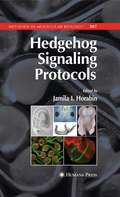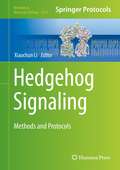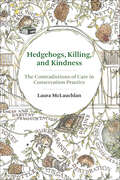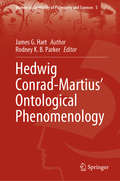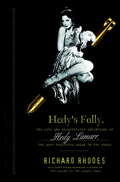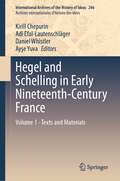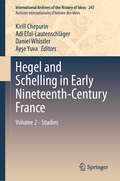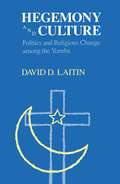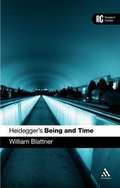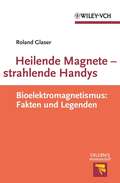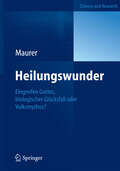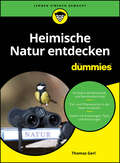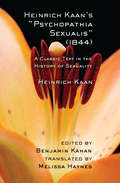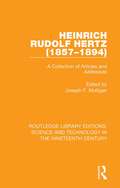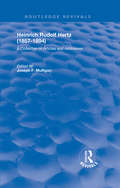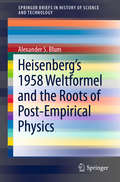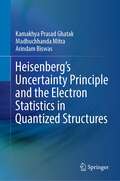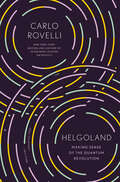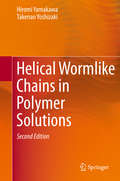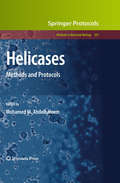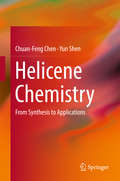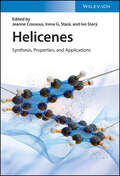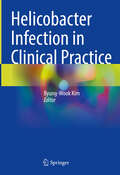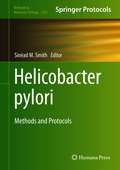- Table View
- List View
Hedgehog Signaling Protocols
by Jamila I. HorabinIntended for Molecular Biologists, Biochemists, and Geneticists interested in manipulating and analyzing the Hedgehog Signaling Pathway, this volume offers various detailed chapters on experimental description, including anecdotal pointers and notes.
Hedgehog Signaling: Methods and Protocols (Methods in Molecular Biology #2374)
by Xiaochun LiThis detailed book explores the technical breakthroughs with biophysical and cell biological approaches that have advanced the study of molecular mechanisms underlying the generation and transduction of the hedgehog (HH) signal, indicating the important role of sterols in this pathway. Within its pages, the volume examines techniques involving several key protein components in this pathway, including HH, the signaling ligand; Dispatched, a HH secretion regulator; Patched, the receptor of HH; Smoothened, the signal transducer used to transduce the HH signal across the plasma membrane; and GLI, the transcription factor to turn on HH target genes. Written in the highly successful Methods in Molecular Biology series format, chapters feature introductions to their respective topics, lists of the necessary materials and reagents, step-by-step readily reproducible laboratory protocols, as well as tips on troubleshooting and avoiding known pitfalls. Authoritative and practical, Hedgehog Signaling: Methods and Protocols provides researchers in clinical and basic science with a fresh and reliable reference for analyzing HH signal transduction through cell biological, biochemical, and biophysical approaches.
Hedgehogs, Killing, and Kindness: The Contradictions of Care in Conservation Practice
by Laura McLauchlanHow our understanding of and relationship to hedgehogs reveals the complex interactions between culture, technology, bodies, conservation, and care for other animals.Across the globe, the bumbling hedgehog has been framed in a variety of ways throughout history—as a symbol of both good and bad luck, of transformation, of vengeance, and of wit and reincarnation. In recent years, it has also, in different parts of the world, been viewed as a pest for its predation on ground-nesting birds and has thus become a target for culling. In Hedgehogs, Killing, and Kindness, Laura McLauchlan explores how human actors have interacted with hedgehogs and other species through time and attends to the questions these interactions raise when it comes to ending and preserving life in the name of species conservation and wildlife rehabilitation.Grounded in rich empirical material and careful critique, Hedgehogs, Killing, and Kindness traces the author&’s own more-than-human transformative experience and elucidates how care is shaped by and shapes various cultural and material forces. McLauchlan urges us to rethink and reflect on how cares are normalized, and at what and whose expense; what it might mean to care in more responsive ways; and finally, whether it is possible to kill with kindness in this rapidly changing and conflicting world. A valuable addition to the understanding and practices of multispecies ethnography, environmental anthropology, and the broader environmental humanities, this book sheds a necessary light on the fraught space between caring for and killing to care for other-than-human animals on our one precious planet.
Hedwig Conrad-Martius’ Ontological Phenomenology (Women in the History of Philosophy and Sciences #5)
by James G. HartThis work is an introduction to the totality of the metaphysical philosophy of nature of Hedwig Conrad-Martius (1888-1966). Her own training and inclination as a realist phenomenologist enables a unique perspective on central issues in modern and contemporary (twentieth century) theoretical biology and physics. Here we find novel theories of, e.g., space and time, as well as development and evolution. This work is thus of interest to anyone studying the history of the phenomenological movement as well as religious cosmology.The philosophical basis for this cosmology is Conrad-Martius’ “realontology” which is a phenomenological account of the essence of appearing reality. The full elaboration of the modes of appearing of what is real enables the unfolding of an analogical theory of “selfness” within the order of nature culminating in an account of the coming to be of humans, for whom there is an essentially distinctive world- and self-manifestation for which she reserves the term “spirit.” Key to her position is the revival of ancient metaphysical themes in new transformed guises, especially potentiality and entelechy.Nature’s status, as a self-actuation of world-constituting essence-entelechies, places Conrad-Martius in the middle of philosophical-theological discussions of, e.g., the hermeneutical mandate of demythologization as well as the nature of evolution. Of special interest is her insistence on both nature’s self-actuating and evolving powers and a robust theory of creation.
Hedy's Folly: The Life and Breakthrough Inventions of Hedy Lamarr, the Most Beautiful Woman in the World
by Richard RhodesWhat do Hedy Lamarr, avant-garde composer George Antheil, and your cell phone have in common? The answer is spread-spectrum radio: a revolutionary invention based on the rapid switching of communications signals among a spread of different frequencies. Without this technology, we would not have the digital comforts that we take for granted today. Only a writer of Richard Rhodes's caliber could do justice to this remarkable story. Unhappily married to a Nazi arms dealer, Lamarr fled to America at the start of World War II; she brought with her not only her theatrical talent but also a gift for technical innovation. An introduction to Antheil at a Hollywood dinner table culminated in a U.S. patent for a jam- proof radio guidance system for torpedoes--the unlikely duo's gift to the U.S. war effort. What other book brings together 1920s Paris, player pianos, Nazi weaponry, and digital wireless into one satisfying whole? In its juxtaposition of Hollywood glamour with the reality of a brutal war, Hedy's Folly is a riveting book about unlikely amateur inventors collaborating to change the world.From the Hardcover edition.
Hegel and Schelling in Early Nineteenth-Century France: Volume 1 - Texts and Materials (International Archives of the History of Ideas Archives internationales d'histoire des idées #246)
by Daniel Whistler Kirill Chepurin Adi Efal-Lautenschläger Ayşe YuvaHegel and Schelling in Early Nineteenth-Century France is a two-volume work that documents the French reception of G. W. F. Hegel and F. W. J. Schelling from 1801 to 1848. It shows that the story of the "French Hegel" didn't begin with Wahl and Kojève by giving readers a solid understanding of the various ways in which German Idealism impacted nineteenth-century French philosophy, as well as providing the first ever English-language translations of excerpts from the most important philosophical texts of the era. Inside volume one, readers will find a number of interpretative frameworks to help them get to grips with this neglected field in the history of ideas. In addition to excerpted translations and a narrative of Hegel’s and Schelling’s fate in France during the early nineteenth century, this volume includes an introduction on transnational reception history, as well as an analytical catalogue of the translations of their work produced in French at this time, of the publications which appropriated or interrogated their philosophical legacy, and of the journals, institutional structures and other mechanisms of dissemination that brought Hegel’s and Schelling’s philosophy into France. The book thus details the ways in which French philosophers of the period took up the debates and concepts of German Idealism, transformed them or rejected them. In this way, it aims to contribute to a reversal of the serious neglect of early nineteenth-century French thought in English-language scholarship and, in so doing, goes beyond a nation-based narrative of the history of philosophy. Figures covered in the volumes include major philosophers such as Cousin, Leroux, Proudhon, Quinet, Ravaisson, Renouvier and Véra, as well as more neglected figures, like Barchou de Penhoën, Bénard, Lèbre, Lerminier, Pictet, and Willm.
Hegel and Schelling in Early Nineteenth-Century France: Volume 2 - Studies (International Archives of the History of Ideas Archives internationales d'histoire des idées #247)
by Daniel Whistler Kirill Chepurin Adi Efal-Lautenschläger Ayşe YuvaHegel and Schelling in Early Nineteenth-Century France is a two-volume work that documents the French reception of G. W. F. Hegel and F. W. J. Schelling from 1801 to 1848. It shows that the story of the "French Hegel" didn't begin with Wahl and Kojève by giving readers a solid understanding of the various ways in which German Idealism impacted nineteenth-century French philosophy, as well as providing the first ever English-language translations of excerpts from the most important philosophical texts of the era. Inside volume two, readers will find a series of scholarly studies to help them get to grips with this neglected field in the history of ideas. The contributors are world-leading and emerging experts from Europe, UK, and North America. They highlight the stakes and trace the pathways of this reception for French and German thought during the period, including the ways in which French philosophers of the period took up the debates and concepts of German Idealism, transformed them or rejected them. In this way, the volume aims to redress the serious neglect of early nineteenth-century French thought in English-language scholarship and, in so doing, goes beyond a nation-based narrative of the history of philosophy. Figures covered in the volumes include major philosophers such as Cousin, Leroux, Proudhon, Quinet, Ravaisson, Renouvier and Véra, as well more neglected figures, like Barchou de Penhoën, Bénard, Lèbre, Lerminier, Pictet, and Willm.
Hegel, the End of History, and the Future
by Eric Michael DaleIn Phenomenology of Spirit (1806) Hegel is often held to have announced the end of history, where 'history' is to be understood as the long pursuit of ends towards which humanity had always been striving. In this, the first book in English to thoroughly critique this entrenched view, Eric Michael Dale argues that it is a misinterpretation. Dale offers a reading of his own, showing how it sits within the larger schema of Hegel's thought and makes room for an understanding of the 'end of history' as Hegel intended. Through an elegant analysis of Hegel's philosophy of history, Dale guides the reader away from the common misinterpretation of the 'end of history' to other valuable elements of Hegel's arguments which are often overlooked and deserve to endure. His book will be of great interest to scholars and advanced students of Hegel, the philosophy of history, and the history of political thought.
Hegemony And Culture: Politics And Religious Change Among The Yoruba
by David D. LaitinIn this ambitious work, David D. Laitin explores the politics of religious change among the Yoruba of Nigeria, then uses his findings to expand leading theories of ethnic and religious politics.
Heidegger's Being and Time (Reader's Guides)
by William Blattner<p>Continuum's Reader's Guides are clear, concise and accessible introductions to classic works of philosophy. Each book explores the major themes, historical and philosophical context and key passages of a major philosophical text, guiding the reader toward a thorough understanding of often demanding material. Ideal for undergraduate students, the guides provide an essential resource for anyone who needs to get to grips with a philosophical text. <p><i>Heidegger's Being and Time</i> is one of the most influential and controversial philosophical treatises of the 20th century. It had a profound impact on Sartre and Merleau-Ponty in their further development of phenomenology and existentialism, hugely influenced Gadamer's hermeneutics, and paved the way, partly directly and partly indirectly through Heidegger's later thought, for the emergence of deconstructionism. In addition to being a very important text, it is also a very difficult one. Heidegger presents a number of challenges to the the reader, asking them to abandon many assumptions fundamental to traditional philosophy, such as the mind/body distinction and the concept of substance. The text also introduces a whole host of new concepts and terms and as such is a hugely challenging, yet fascinating, piece of philosophical writing. <p>In <i>Heidegger's Being and Time: A Reader's Guide</i>, William Blattner explains the philosophical background against which the book was written and provides a clear and concise overview of the key themes and motifs. The book then examines this challenging text in details, guiding the reader to a clear understanding of Heidegger's work as a whole. Finally Blattner explores the reception and influence of the work and offers the student guidance on further reading. This is the ideal companion to study of this most influential and challenging of texts.
Heilende Magnete - strahlende Handys: Bioelektromagnetismus: Fakten und Legenden (Erlebnis Wissenschaft)
by Roland GlaserWhile the other works in the "Erlebnis Wissenschaft" series have concentrated on chemical substances in everyday life, this book brings to life a passionately debated physical phenomenon that has equally become an integral part of our lives - so-called electrosmog. The term itself is misleading from the start, such that an objective scientific treatment is urgently needed. The author is one of Europe's leading experts in the field.
Heilungswunder
by Yvonne MaurerHeilungswunder sind umstritten. Die unterschiedlichen Sichtweisen, die in den christlichen Konfessionen vertreten werden, sind in dem Buch dargelegt. Ausgehend von einem pluralistischen Ansatz, wird die Frage diskutiert, inwieweit Heilungs(zusatz)angebote sinnvoll sind - anhand der unterschiedlichen medizinischen, theologischen und philosophischen Positionen sowie der Perspektive der Volksfrömmigkeit. Der Band bündelt Expertenwissen aus unterschiedlichen Disziplinen und ist zugleich Leitfaden für seelsorgerisch und (psycho)therapeutisch Tätige.
Heimische Natur entdecken für Dummies (Für Dummies)
by Thomas GerlEntdecken Sie Wunder der Natur direkt vor der eigenen Haustür Entdecken Sie, was die Natur zu bieten hat. Dazu müssen Sie nicht weit reisen, sondern beginnen direkt vor Ihrer Haustür. Thomas Gerl erklärt Ihnen, was es über die größten heimischen Naturräume zu wissen gibt. Sie lernen die jeweiligen Besonderheiten und die interessantesten Bewohner kennen. So bekommen Sie ein eindrückliches Bild von den Lebewesen Ihrer Region, angereichert mit biologischen Hintergrundinformationen und vielen praktischen Tipps für erfolgreiche Naturbeobachtungen. An konkreten Beispielen erfahren Sie außerdem, wie sich der Rückgang der biologischen Vielfalt auswirkt und wie Sie dabei helfen, ihn zu stoppen. Sie erfahren Wie sich die Vielfalt des Lebendigen ordnen lässt Was Sie bei Erkundungstouren in der Natur beachten sollten Wo und wie Sie bestimmte Tiere und Pflanzen finden Wie Naturbeobachtung dazu beiträgt, Lebewesen zu erhalten
Heinrich Kaan’s “Psychopathia Sexualis”: A Classic Text in the History of Sexuality
by Melissa Haynes Benjamin A. Haynes Heinrich Kaan"With Heinrich Kaan's book we have then what could be called the date of birth, or in any case the date of the emergence, of sexuality and sexual aberrations in the psychiatric field." Michel Foucault, Abnormal: Lectures at the Collège de France, 1974-1975Heinrich Kaan's fascinating work--part medical treatise, part sexual taxonomy, part activist statement, and part anti-onanist tract--takes us back to the origins of sexology. He links the sexual instinct to the imagination for the first time, creating what Foucault called "a unified field of sexual abnormality." Kaan's taxonomy consists of six sexual aberrations: masturbation, pederasty, lesbian love, necrophilia, bestiality, and the violation of statues. Kaan not only inaugurated the field of sexology, but played a significant role in the regimes of knowledge production and discipline about psychiatric and sexual subjects. As Benjamin Kahan argues in his Introduction, Kaan's text crucially enables us to see how homosexuality replaced masturbation as the central concern of Euro-American sexual regulation. Kaan's work (translated into English for the first time here) opens a new window onto the history of sexuality and the history of sexology and reconfigures our understanding of Richard von Krafft-Ebing's book of the same name, published some forty years later.
Heinrich Rudolf Hertz: A Collection of Articles and Addresses (Routledge Library Editions: Science and Technology in the Nineteenth Century #6)
by Joseph F. MulliganThis book, first available in 1994, was published to commemorate the one-hundredth anniversary of Heinrich Hertz’s death at the terribly young age of thirty-six. The introductory biography together with eleven papers by Hertz and seven about him are intended to highlight the importance of Hertz’s contributions to physics and at the same time to serve the needs of anyone interested in doing research on this highly gifted scientist.
Heinrich Rudolf Hertz: A Collection of Articles and Addresses (Routledge Revivals #6)
by Joseph F. MulliganPublished in 1994: This book is to commemorate the one hundredth anniversary of Heinrich Hertz’s death at the terribly young age of thirty-six. The introductory biography together with eleven papers by Hertz and seven about him are intended to highlight the importance of Hertz’s contributions to physics and at the same time to serve the needs of anyone interested in doing research on this highly gifted scientist.
Heisenberg’s 1958 Weltformel and the Roots of Post-Empirical Physics (SpringerBriefs in History of Science and Technology)
by Alexander S. BlumThis book presents the first detailed account of Werner Heisenberg’s failed attempt to find a theory of everything in the autumn of his career. It further investigates what we can learn from his failure in relation to the search for a final theory of physics, an endeavour that continues to define research in fundamental physics to this day. Thereby it provides the first historically informed contribution to the current debate on post-empirical physics and the state of particle physics.
Heisenberg’s Uncertainty Principle and the Electron Statistics in Quantized Structures
by Kamakhya Prasad Ghatak Madhuchhanda Mitra Arindam BiswasThis book highlights the importance of Electron Statistics (ES), which occupies a singular position in the arena of solid state sciences, in heavily doped (HD) nanostructures by applying Heisenberg’s Uncertainty Principle directly without using the complicated Density-of-States function approach as given in the literature. The materials considered are HD quantum confined nonlinear optical, III-V, II-VI, IV-VI, GaP, Ge, PtSb2, stressed materials, GaSb, Te, II-V, Bi2Te3, lead germanium telluride, zinc and cadmium diphosphides, and quantum confined III-V, IV-VI, II-VI and HgTe/CdTe super-lattices with graded interfaces and effective mass super-lattices. The presence of intense light waves in optoelectronics and strong electric field in nano-devices change the band structure of materials in fundamental ways, which have also been incorporated in the study of ES in HD quantized structures of optoelectronic compounds that control the studies of the HD quantum effect devices under strong fields. The influence of magnetic quantization, magneto size quantization, quantum wells, wires and dots, crossed electric and quantizing fields, intense electric field, and light waves on the ES in HD quantized structures and superlattices are discussed. The content of this book finds six different applications in the arena of nano-science and nanotechnology and the various ES dependent electronic quantities, namely the effective mass, the screening length, the Einstein relation and the elastic constants have been investigated. This book is useful for researchers, engineers and professionals in the fields of Applied Sciences, solid state and materials science, nano-science and technology, condensed matter physics, and allied fields, including courses in semiconductor nanostructures.
Helgoland: Making Sense of the Quantum Revolution
by Carlo Rovelli&“Rovelli is a genius and an amazing communicator… This is the place where science comes to life.&” ―Neil Gaiman &“Helgoland is Rovelli&’s most beautiful yet… Unforgettable.&” ―The London Times A startling new look at quantum theory, from the New York Times bestselling author of Seven Brief Lessons on Physics and The Order of Time.One of the world's most renowned theoretical physicists, Carlo Rovelli has entranced millions of readers with his singular perspective on the cosmos. In Helgoland, he examines the enduring enigma of quantum theory. The quantum world Rovelli describes is as beautiful as it is unnerving.Helgoland is a treeless island in the North Sea where the twenty-three-year-old Werner Heisenberg made the crucial breakthrough for the creation of quantum mechanics, setting off a century of scientific revolution. Full of alarming ideas (ghost waves, distant objects that seem to be magically connected, cats that appear both dead and alive), quantum physics has led to countless discoveries and technological advancements. Today our understanding of the world is based on this theory, yet it is still profoundly mysterious.As scientists and philosophers continue to fiercely debate the meaning of the theory, Rovelli argues that its most unsettling contradictions can be explained by seeing the world as fundamentally made of relationships rather than substances. We and everything around us exist only in our interactions with one another. This bold idea suggests new directions for thinking about the structure of reality and even the nature of consciousness.Rovelli makes learning about quantum mechanics an almost psychedelic experience. Shifting our perspective once again, he takes us on a riveting journey through the universe so we can better comprehend our place in it.
Helical Wormlike Chains in Polymer Solutions
by Hiromi Yamakawa Takenao YoshizakiThis book presents the "helical wormlike chain" model - a general model for both flexible and semiflexible polymer chains. It explains how statistical-mechanical, hydrodynamic, and dynamic theories of their solution properties can be developed on the basis of this model. This new second edition has been carefully updated and thoroughly revised. It includes a new chapter covering "Simulation and More on Excluded-Volume Effects", as well as the discussion of new experimental data and the application of the theory to ring polymers. The authors provide analysis of important recent experimental data by the use of their theories for flexible polymers over a wide range of molecular weights, including the oligomer region, and for semiflexible polymers, including biological macromolecules such as DNA. This is all clearly illustrated using a reasonable number of theoretical equations, tables, figures, and computer-aided forms, which support the understanding of the basic theory and help to facilitate its application to experimental data for the polymer molecular characterization.
Helicases
by Mohamed M. AbdelhaleemIn recent years, much information has been revealed concerning the essential role of helicases, the enzymes that utilize the energy derived from nucleoside triphosphate hydrolysis to unwind the double stranded helical structure of nucleic acids. In Helicases: Methods and Protocols, this topic is explored by leading international scientists who have contributed significantly to our current understanding of helicases and the ways in which they function. Chapters include methods for the production and purification of helicases from different species, as well as detailed studies of helicase activities, including NTP binding and hydrolysis, nucleic acid binding and unwinding, and translocation along nucleic acid substrates. Composed in the highly successful Methods in Molecular BiologyTM series format, each chapter contains a brief introduction, step-by-step methods, a list of necessary materials, and a Notes section which shares tips on troubleshooting and avoiding known pitfalls. Wide-ranging and innovative, Helicases: Methods and Protocols is the ultimate guide for researchers, providing the scientific community with comprehensive accounts of the most advanced methods used to study helicases today.
Helicene Chemistry
by Chuan-Feng Chen Yun ShenThis book systematically reviews recent advances in the synthetic methods and applications of helicenes. The first part of this book introduces the nomenclature and structural features of helicenes. The second part reviews several classic and useful methods as well as recently-developed approaches for the preparation and functionalization of helicenes, including photocyclization and Diels-Alder reactions, which are two important breakthroughs in the syntheses of helicenes. In the last part, the applications of helicenes in asymmetric syntheses, molecular machines, molecular recognition, self-assembly and other fields are discussed. This book provides a useful reference source for researchers and graduate students working not only in the area of helicene chemistry, but also in other research areas including materials science, supramolecular chemistry, coordination chemistry, and physical organic chemistry. Chuan-Feng Chen is a Professor at the Institute of Chemistry, Chinese Academy of Sciences, China.
Helicenes: Synthesis, Properties, and Applications
by Jeanne Crassous Irena G. Stará Ivo StarýHelicenes A thorough introduction to everything there is to know about this fascinating compound class The intriguing nature of this highly interesting compound class has inspired much research over the last decade, and much of what has been produced is highly interdisciplinary, with applications found in catalysis, material science, and spectroscopy. Indeed, the field has reached maturity such that elegant synthetic methods are now available and novel applications in arenas such as enantioselective catalysis and optoelectronics are appearing. Helicenes provides not only an introduction to the synthesis of the fascinating compound class of helicenes, but also describes the properties and, most importantly, their applications. The book thoroughly explains several synthetic routes from classical to state-of-the-art methods. In addition, the different classes of helicene-based molecules – organic, organometallic, oligo-meric, and multidimensional – are covered. Helicenes readers will also find: Edited by world-leading experts in the field of chirality A comprehensive and well-structured approach that deals with every aspect of this compound class Discussions of the applications of helicenes in organic synthesis, photophysics, material science, optoelectronic devices, on-surface chemistry, and theoretical calculations A special focus on the applications of helicenes in catalysis, optoelectronics, non-linear optics, and chiroptical spectroscopy Chapters focusing on helicenes as theoretical helically chiral models Helicenes is an essential reference for organic chemists, materials scientists, spectroscopists, polymer chemists, inorganic chemists, and catalytic chemists, as well as students in these fields and libraries supplying them.
Helicobacter Infection in Clinical Practice
by Byung-Wook KimAlthough the incidence of Helicobacter infection has been declining for the past decades, it is still one of the most common infectious disease all over the world. Over 50,000 research articles have been published so far and lots of studies are on-going. Most of previously published books dealt with so many issues and it is somewhat hard for the reader to apply in real world clinical practice. Since clinicians do not have enough time to read the book from head to the end, this book presents algorithms, tables, and figures at the end of each chapter to provide a brief summary for clinicians, so that they can use this book as a reference in a short time in clinical practice. Readers will find up-to-date information and guidance on diagnosis and different types of treatments.
Helicobacter Pylori (Methods in Molecular Biology #2283)
by Sinéad M. SmithThis book brings together a collection of methods for the successful detection, culture and investigation of H. pylori, and its associated diseases. Chapters guide the reader through overviews on H. pylori infection, protocols for analyzing human clinical samples, and protocols for characterizing H. pylori, its functional components and its interactions with host cells. Written in the highly successful Methods in Molecular Biology series format, chapters include introductions to their respective topics, lists of the necessary materials and reagents, step-by-step, readily reproducible laboratory protocols, and tips on troubleshooting and avoiding known pitfalls. Authoritative and cutting-edge, Helicobacter pylori: Methods and Protocols aims to be a useful practical guide to researchers to help further their study in this field.
